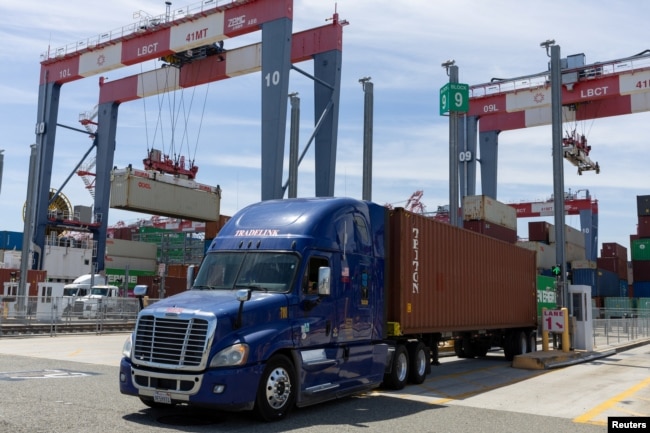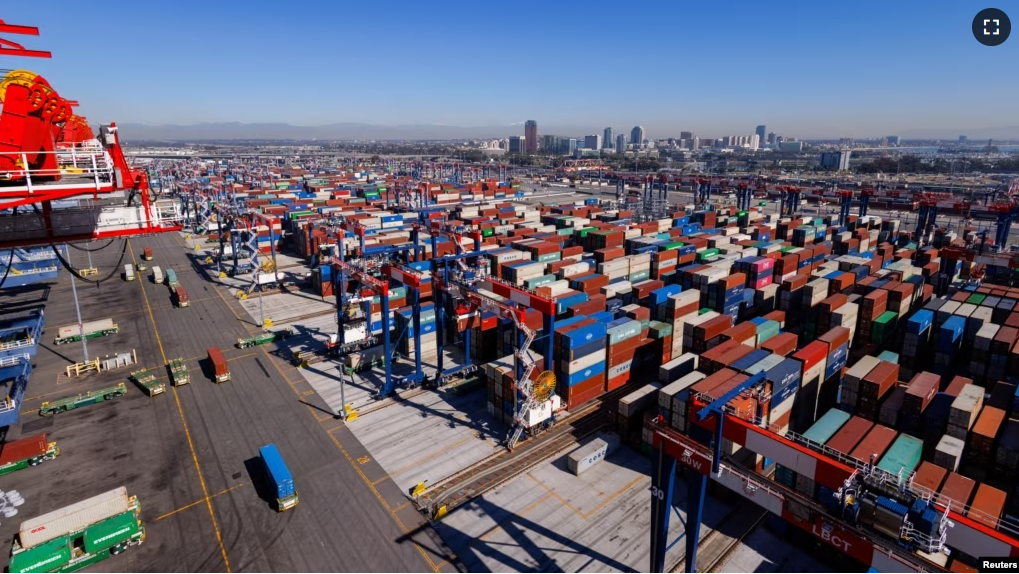The port at Long Beach, California is one of the busiest in the United States. Its owners are making changes to the equipment used to move containers from ships and around the port.
The U.S. government is paying for some of the changes. The company wants to buy electric work vehicles and automated machinery. The goal is to reduce the production of carbon gases and improve performance at the port. But the workers are concerned about keeping their jobs.
Anthony Otto works for the Australian company Macquarie. It purchased the port in 2019. Otto is the port’s chief executive.
Macquarie started a port electrification project. Its goal was to make the port more effective and to use less power. The electrification project meant a lot of the equipment is to run on power from the state’s electricity grid and not from motors that run on fuel.

Otto said the Long Beach port’s performance improved in 2022. It moved three times the cargo compared to 2019 and created 90 percent less carbon gases.
The people who work there direct self-driving machines to move heavy containers. Others use hand-held controls to move containers on and off ships and trains with robots. Sensors in the pavement help small vehicles and large trucks move through the port area.
Otto said truckers spent less time last year waiting to pick up or drop off containers. That also reduced pollution from diesel fuel engines.
But port workers, who are part of a labor organization, worry that robots, self-driving vehicles, and electrification will cost them their jobs.
Otto said even if some traditional jobs for port workers are gone, new technology has created other jobs. But in a discussion with the Reuters news agency, he would not discuss the job cuts. He did say, however, that the company spends more money on worker salaries than before.

The U.S. Environmental Protection Agency says transportation, which includes work at ports, is one of the nation’s biggest producers of carbon gases. Those gases have been linked to warming of the Earth’s atmosphere. Making more ports electric would reduce the number of large diesel engines that release carbon gases. Also, with electrification, more jobs can be automated.
However, some reports say automation reduces jobs. One labor group that represents port workers in California said in 2020 and 2021, the Long Beach port lost almost 400 jobs that would have existed had it not been automated.
The next step in the process at Long Beach is to use $30 million to buy large electric vehicles that can move heavy containers. The money comes from the U.S. government. The port received the money based on a plan to release no carbon emissions by 2030.
The government money comes with a requirement that the new equipment cannot result in a loss of total jobs or reduce the quality of the jobs. The port workers hope the company that runs the port follows those rules.
The Pacific Maritime Association is a non-profit industry group. In a report, it said the number of hours paid to workers at Long Beach and another port in Los Angeles increased by over 30 percent from 2015 to 2021. That was during the period of automation at Long Beach.

Even as port operators look to automate more jobs, two independent reports said that might not be the best idea. One of the reports, by business advisor McKinsey and Co., found that automated ports are not more productive than ports with mainly human workers. That is because when the automated ports get busy, they cannot call in extra workers.
Jaime Hipsher is a member of the workers’ group. She said her father worked at the ports but lost his job. He worked at a coal processing center. Hipsher said a change in the way ports use energy resulted in some job losses, and she is worried about more losses because of electrification.
She said, often “electrification is connected with automation.” Hipsher added, “That isn’t necessarily the way electrification needs to go.”
I’m Dan Friedell.
Dan Friedell adapted this story for Learning English based on a story by Reuters.
___________________________________________________________________
Words in This Story
grid –n. the network of power lines and stations that send electricity to users like businesses, factories and homes
cargo –n. loads of products or goods that are carried by boats, planes, trains or other vehicles to be delivered to whoever ordered them
salary –n. the money paid to a worker for their labor
automated –adj. using robots and machines rather than people to get work done
